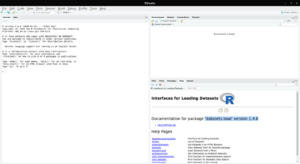Software:Datasets.load
 datasets.load GUI searching and loading datasets | |
| Original author(s) | Bastiaan Quast |
|---|---|
| Initial release | 14 December 2016 |
| Stable release | 1.4.0
/ 27 April 2020 |
| Preview release | 1.4.0.9000
/ 1 May 2020 |
| Repository | https://github.com/bquast/datasets.load |
| Written in | R |
| Operating system | Windows, MacOS, Linux |
| Size | 520.6 kB (v. 1.2.0) |
| Available in | R |
| License | GPL v3 |
| Website | cran.r-project.org |
datasets.load is an R package and RStudio plugin, that provides both a Graphical User Interface (GUI), as well as a Command Line Interface for loading datasets.[1] Normally, R only makes visible datasets of packages that are loaded, datasets.load shows the list of all installed datasets on the local library, including datasets included with packages that are not loaded. It is one of the top 10% of most downloaded R packages.
R datasets
R functionality is extendible using extensions call R packages. The central place from which to install packages is the Central R Archive network (CRAN). From CRAN, R packages can be installed using the command (here to install datasets.load):
install.packages('datasets.load')
Once installed, R packages can be loaded using the command:
library(datasets.load)
After a package has been loaded, objects available from the package - such as functions and datasets - can be accessed.
The datasets from all the loaded packages can listed using the command:
data()
However, datasets from packages that are not loaded, are not listed. As a result, many R users have access to datasets on their local install that are never used. The datasets.load packages addresses this by listed all datasets that are in any packages installed (loaded or not loaded).
Usage
A video demonstrating the GUI usage is available via the thumbnail on the right and on YouTube.
The usage of datasets.load's Command Line Interface is demonstrated in the code snippet below.
> # install the datasets.load package
> install.packages('datasets.load')
> # load the datasets.load package
> library(datasets.load)
> # list the objects in the package (all functions)
> ls("package:datasets.load")
[1] "alldata" "browseDatasets" "datasets" "datasets.load" "getDatasetInfo" "printDatasets"
[7] "promptDatasets"
> # show all datasets (in a new window)
> datasets()
Functionality
The basic functionality of datasets.load is to expose all installed datasets to the user, including datasets in packages that are not loaded. There is a Command Line Interface (CLI) which can be used from any R terminal.
In addition to the CLI, there is also a Graphical User Interface for RStudio using RStudio Addins.
Reception
The initial release on CRAN of version 0.1.0 took place in December 2016, and averaged a download rate of 1,000 times per month, from the RStudio servers alone. With the release of version 0.3.0 in 2018, the download rate increased to 2,000 times per month, putting the package in the 9th percentile of most popular R packages.[2] The package was reviewed in the 2017 article "R Packages worth a look" on Data Analytics & R,[3] which further increased usage. It is also frequently preinstalled on university computers,[4] in order to help make R more accessible to students.
Version 1.0.0 was released on 12 December 2019, with a version 1.4.0 which was built against R 4.0.0 being released on 27 April 2020.[4]
The RStudio CRAN mirror download logs [5] show that the package is downloaded more than 2,000 times per month from those servers ,[6] with a total of over 65,000 downloads since the first release ,[7] according to RDocumentation.org, this puts the package in the 9th percentile of most popular R packages.[8] On Rdocumentation.org it is listed as the second most downloaded package under the keyword "datasets"[9] (after the base R package datasets), with "datasets" being the most popular keyword on Rdocumentation.org.[10]
References
- ↑ Quast, Bastiaan (2019-12-12), datasets.load: Interfaces for Loading Datasets, https://cran.r-project.org/package=datasets.load, retrieved 2020-04-30
- ↑ Quast, Bastiaan (2020-04-30), Visual interface for loading datasets in RStudio, https://github.com/bquast/datasets.load, retrieved 2020-05-01
- ↑ Laux, Michael (2017-01-05). "R Packages worth a look" (in en-US). Data Analytics & R. https://advanceddataanalytics.net/2017/01/05/r-packages-worth-a-look-667/.
- ↑ 4.0 4.1 "R packages installed - ITS - Carlpedia - Carleton College Wiki". https://wiki.carleton.edu/display/itskb/R+packages+installed.
- ↑ "RStudio CRAN logs". http://cran-logs.rstudio.com/.
- ↑ "CRANlogs datasets.load package". https://cranlogs.r-pkg.org/badges/datasets.load.
- ↑ "CRANlogs datasets.load package". https://cranlogs.r-pkg.org/badges/grand-total/datasets.load.
- ↑ "datasets.load package R Documentation". https://www.rdocumentation.org/packages/datasets.load/versions/1.4.0.
- ↑ "RDocumentation: Results for "datasets"". https://www.rdocumentation.org/search?q=datasets.
- ↑ "RDocumentation Trends". https://www.rdocumentation.org/trends.
External links


